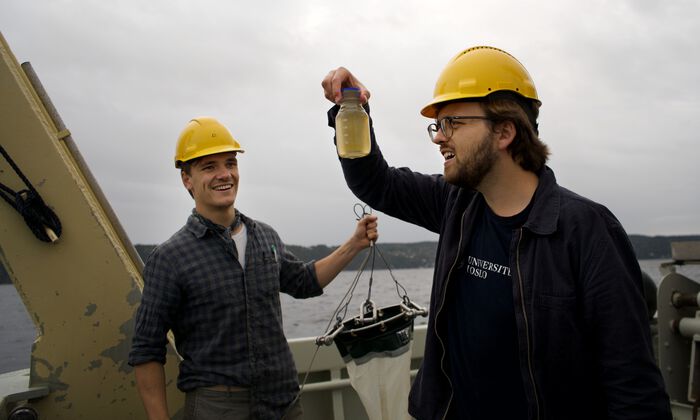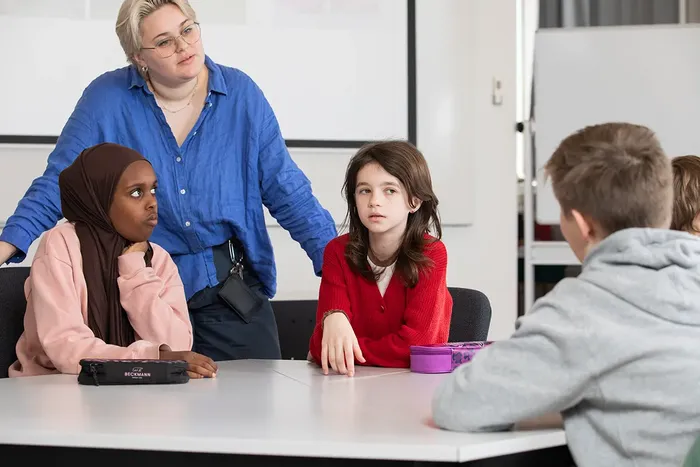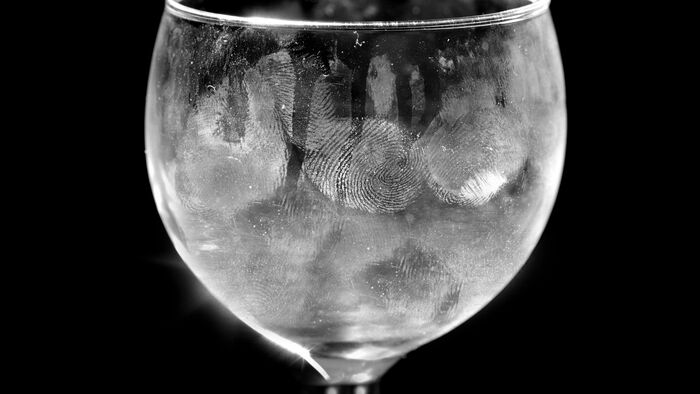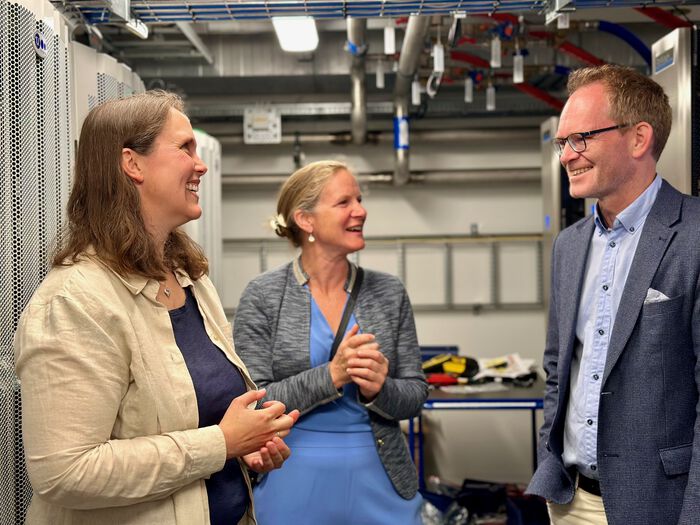
After ten years of operation, the Centre for Ecological and Evolutionary Synthesis (CEES) at the University of Oslo has submitted a final report to the Research Council of Norway. The report contains a long and impressive list of results: Researchers associated with CEES have published more than 1450 scientific papers, of which 14 in Nature and Science. These articles have again been cited over 30 000 times.
That is more than enough to impress Chief Executive John-Arne Røttingen at the Research Council of Norway, where the decision to fund CEES as a Norwegian Centre of Excellence for ten years was made in 2006.
“It pleases me to see that CEES has managed to develop a large and fertile research environment with excellent conditions for doing innovative research. The results from CEES have made an impact by moving the frontiers in international research forwards in its field of research", says Røttingen.
Impressing list of achievements
Rector Svein Stølen at the University of Oslo is also happy about the results from CEES.
"The list of achievements from CEES is truly impressing. With Professor Stenseth as a leader, the centre has made scientific discoveries, developed new forms of teaching, and focused on young talents. CEES is now one of Norway’s leading research communities, with a recognition that stretches far beyond our national borders”, Stølen says.

Professor Stenseth himself is a bit surprised by the total number of publications and citations.
“I knew we were doing well, but this is even better than I expected", he says. Stenseth is pleased that the board of the host institution, the Department of Biosciences at the University of Oslo has decided that CEES shall continue as a centre, even if the shape of the future centre isn’t decided in detail yet.
The final report to the Research Council also shows that CEES researchers have been very active in communicating their research. Professor Stenseth and colleagues have been frequently interviewed in a multitude of media. They have also written their own articles about topics as diverse as the cod genome, the plague in Europe, speciation in sparrows, the Viking and their trade with cod and walrus ivory, penguins threatened by climate change, and so on.
Professor Stenseth was awarded the Norwegian Research Council's Award for Excellence in Communication of Science in 2012.
The strange cod genome

When Stenseth is asked about the most important contributions from CEES, he emphasizes two discoveries. The researchers at CEES showed the world that the atlantic cod (Gadus morhua) has a very strange and interesting genome, and that the Black Death – also known as the Plague – came to Europe not once but several times during the Middle Ages.
"We had strategic reasons for wanting to investigate the cod genome. The idea came from Professor Kjetill S. Jakobsen, partly because the cod is a species of great economic importance, and we agreed that this was a great opportunity to develop a new field of science”, Stenseth explains.
When the CEES researchers were ready to send their scientific paper about the sequencing of the cod genome to Nature, the journal had recently published an innovative paper about the genome of the giant panda. That implied that it was no longer possible to publish new papers about genome sequencing, unless you had an additional story to tell. And that was exactly what the CEES researchers were preparing.
“We had discovered that the cod has a very special immune system, without the important part that protects against dangerous bacteria in other species and makes it possible to “remember” older infections. If humans lacked the same part, we could risk dying from the tiniest scratch. But the cod is doing just fine”, says Stenseth.
This finding opened the door to a series of new studies. Only this year, CEES researchers have reported that a tiny carp that lives like a larva throughout its whole life in peat swamp forests in Indonesia and Malaysia, has a very small and strange genome. They have also discovered that the so-called antifreeze proteins in codfish can be formed after mutations in noncoding DNA.
Nils Chr. Stenseth emphasizes that the study of the cod's genome was led by Professor Kjetill S. Jakobsen and researcher Sissel Jentoft.
“By the way, there was nothing about sequencing the cod genome in our original application to the Research Council. But we have always been open for changes when new opportunities arise. I like to say that I don’t care what people are doing here, as long as they are doing good work! Creating excellent science that can – and has been – published in top journals”.
The bacterium that changed European history

The researchers at CEES have also discovered new insights about one of the most devastating pandemics in human history, the Black Death. As many people know, the bacterium Yersinia pestis has had an enormous influence on European history: Ca. 50 percent of Europe's population died of plague during the Middle Ages.
Most Norwegian children have learnt in school that the Black Death came to Norway with the rats on a ship to Bergen in 1349, but the real history is a lot more complicated.
“We have shown that Yersinia pestis, which results in several forms of plague, came to Europe several times during the Middle Ages – not only once. Our explanation is that the bacterium lives all the time among rodents in Asia. But when the rodent populations collapse from time to time because they have become too large, the bacterium can start infecting people instead”, Stenseth says.
When the historian, Professor Bruce M. Campbell at the Queen's University of Belfast, read about this research, he became very excited. He later met Stenseth and told him that the new insight from CEES had explained one of the mysteries that had concerned historians: Why did the plague move across Europe in great waves for centuries?
The basic theme
The research at CEES has spanned many themes, but the basic theme has been the same right from the start.
"Everything we have done has been based on the idea that ecology drives evolution – which then affects the ecology. A lot of researchers have been working on the first part of the equation, and a few researchers have looked at the second part. But the study of the interaction, back and forth between evolution and ecology, is where we have made the most important advances”, Stenseth says.
To summarize, CEES has kept a sharp focus on conducting excellent basic research. This is something you can only do if you have excellent researchers.
Stenseth reminds that “skilled researchers have always been our most important resource. The funding from the Research Council of Norway made it possible for us to think strategically and invest a lot in attracting talented young scientists. In addition, we have emphasized creating a good working environment, where there is a very low threshold for asking for help. Activities as diverse as annual conferences for students and daily gatherings around the coffee machine are important parts in creating a fertile research group. We have also put a lot of effort into creating opportunities for everyone. In addition, our administrative staff has performed extremely well!”
Stepping down as the leader of CEES

Professor Nils Chr. Stenseth was the vice-president and president (alternating years) of the Norwegian Academy of Science and Letters from 2009 to 2014. He is also a member of so many major science academies inside and outside Norway that they cannot be listed here. He is now 69 years old and totally without plans to leave the field of science.
But Stenseth is stepping down as the leader of CEES; he will instead become a strategic advisor at the UiO’s Faculty of Mathematics and Natural Sciences. Stenseth's duties will be linked to the establishment and development of strategic initiatives, including participation, on behalf of the faculty, in national and international contexts where the faculty has important interests.
“I would like to thank Nils Chr. Stenseth for his efforts as a researcher, research leader, research policy driver and not least as the leader of a Centre of Excellence for more than 10 years. This effort has yielded great results”, says Morten Dæhlen, dean at the Faculty of Mathematics and Natural Sciences.
“We are a strong research faculty where CEES, with its extensive research production and visibility both nationally and internationally, has been and is one of the spearheads. I am very pleased that we will continue CEES as a centre, and I look forward to new scientific discoveries from this strong environment”, Dæhlen adds.
The future of CEES
But what about CEES in the future?
"I remain convinced that if the Department wants to, the researchers at CEES will be able to continue their excellent work without me as the centre leader: the centre has so many skilled and dedicated people that have created a culture of cooperation. By the way, CEES is not just a research centre in my opinion, but also a brand name. All that is needed is a proper financing and a dedication from the leaders in charge of the Department of Biosciences and the University of Oslo. It remains, however, to be seen whether the necessary means will be provided by the Department”, summarizes Stenseth.
Scientific publications in Nature:
David Houle, Thomas F. Hansen et al.: Mutation predicts 40 million years of fly wing evolution. Nature volume 548, pages 447–450 (24 August 2017)
Indrė Žliobaitė, Mikael Fortelius, Nils Chr. Stenseth: Reconciling taxon senescence with the Red Queen’s hypothesis. Nature volume 552, pages 92–95 (07 December 2017)
Sigbjørn Lien, Sissel Jentoft, Alexander J. Nederbragt, Ave Tooming-Klunderud, Kjetill S. Jakobsen et al.: The Atlantic salmon genome provides insights into rediploidization. Nature volume 533, pages 200–205 (12 May 2016)
Eske Willerslev, Sanne Boessenkool, Laura S. Epp, Eva Bellemain, Anne Krag Brysting, et al.: Fifty thousand years of Arctic vegetation and megafaunal diet. Nature volume 506, pages 47–51 (06 February 2014)
Bastiaan Star, Alexander J. Nederbragt, Sissel Jentoft, Unni Grimholt, Martin Malmstrøm, Tone F. Gregers, Trine B, Rounge, Jonas Paulsen, Monica H. Solbakken, Karin Lagesen, Ave Tooming-Klunderud, Kirubakaran G. Tina, Mari Espelund, Morten Skage, Paul R. Berg, Tor Gjøen, Stig W. Omholt, Nils Chr. Stenseth, Kjetill S. Jakobsen, et al.: The genome sequence of Atlantic cod reveals a unique immune system. Nature volume 477, pages 207–210 (08 September 2011)
Claire Saraux, Céline Le Bohec, Joël M. Durant, Nils C. Stenseth et al.: Reliability of flipper-banded penguins as indicators of climate change. Nature volume 469, pages 203–206 (13 January 2011)
Nils Chr. Stenseth & Erin S. Dunlop: Evolution: Unnatural selection (News & Views). Nature volume 457, pages 803–804 (12 February 2009)
Kyrre L. Kausrud, Atle Mysterud, Jon Olav Vik, Anne Maria Eikeset, Nils Chr. Stenseth et al.: Linking climate change to lemming cycles. Nature volume 456, pages 93–97 (06 November 2008)
Nils Chr. Stenseth & Tristan Rouyer: Ecology: Destabilized fish stocks (News & Views). Nature volume 452, pages 825–826 (17 April 2008).
Scientific publications in Science:
Anthony D. Barnosky, Nils Chr. Stenseth et al.: Merging paleobiology with conservation biology to guide the future of terrestrial ecosystems. Science Vol 355, Issue 6325, 10 February 2017.
Seth Finnegan, Lee Hsiang Liow et al.: Paleontological baselines for evaluating extinction risk in the modern oceans. Science Vol 348, Issue 6234, 01 May 2015.
Thomas Marcussen, Kjetill S. Jakobsen et al.: Ancient hybridizations among the ancestral genomes of bread wheat. Science Vol 345, Issue 6194, 18 July 2014
Philipp Neubauer, Jeffrey A. Hutchings et al.: Resilience and Recovery of Overexploited Marine Populations. Science Vol 340, Issue 6130, 19 April 2013
James J. Elser, Tom Andersen, Dag O. Hessen et al.: Shifts in Lake N:P Stoichiometry and Nutrient Limitation Driven by Atmospheric Nitrogen Deposition. Science Vol 326, Issue 5954, 06 November 2009.
Stein A. Sæther, Glenn-Peter Sætre, Thomas Borge, Gunilla Andersson, Jon Haavie et al.: Sex chromosome-linked species recognition and evolution of reproductive isolation in flycatchers. Science Vol 318, Issue 5847, 05 October 2007.
Niclas Jonzén, Torbjørn Ergon, Endre Knudsen, Jon Olav Vik, Christian Brinch, Nils Chr. Stenseth: Rapid Advance of Spring Arrival Dates in Long-Distance Migratory Birds. Science Vol 312, Issue 5782, 30 June 2006.





